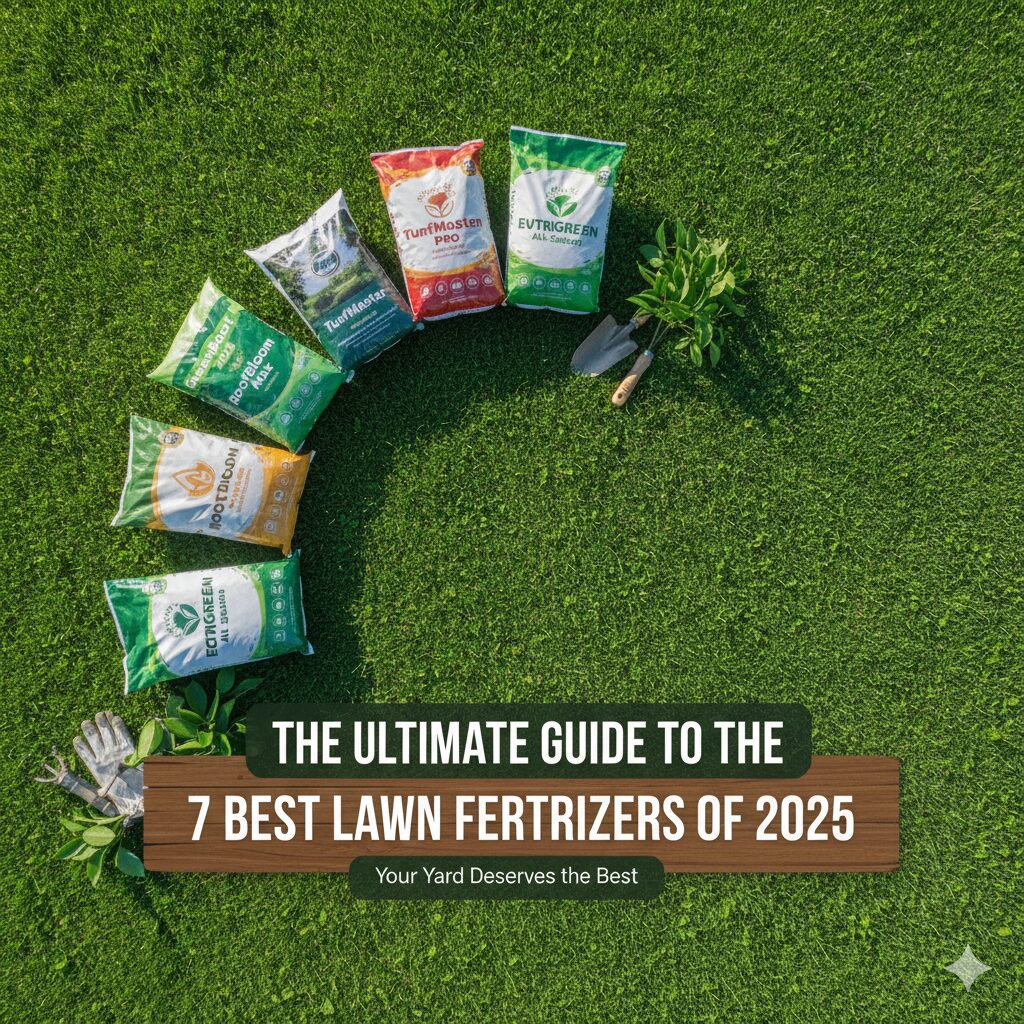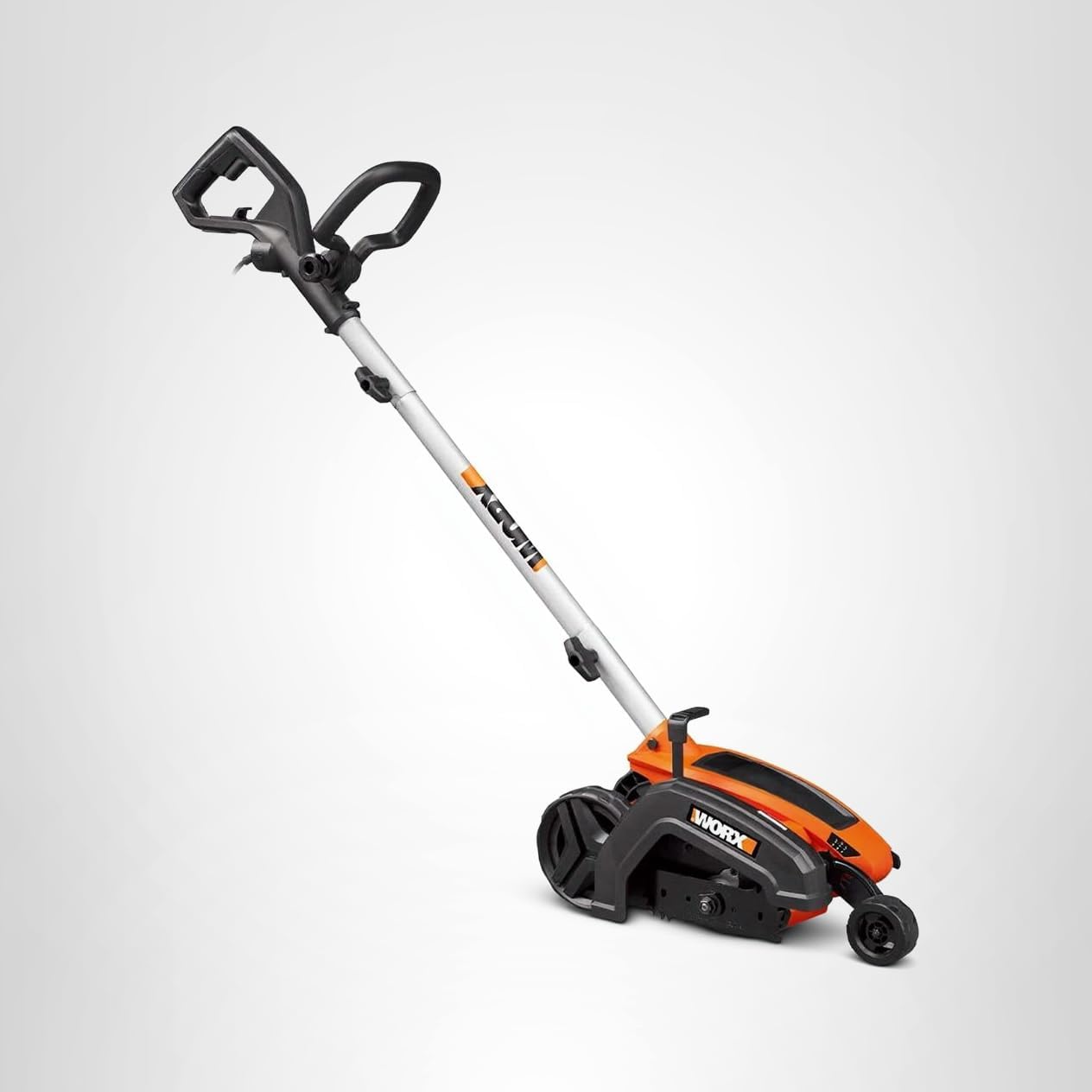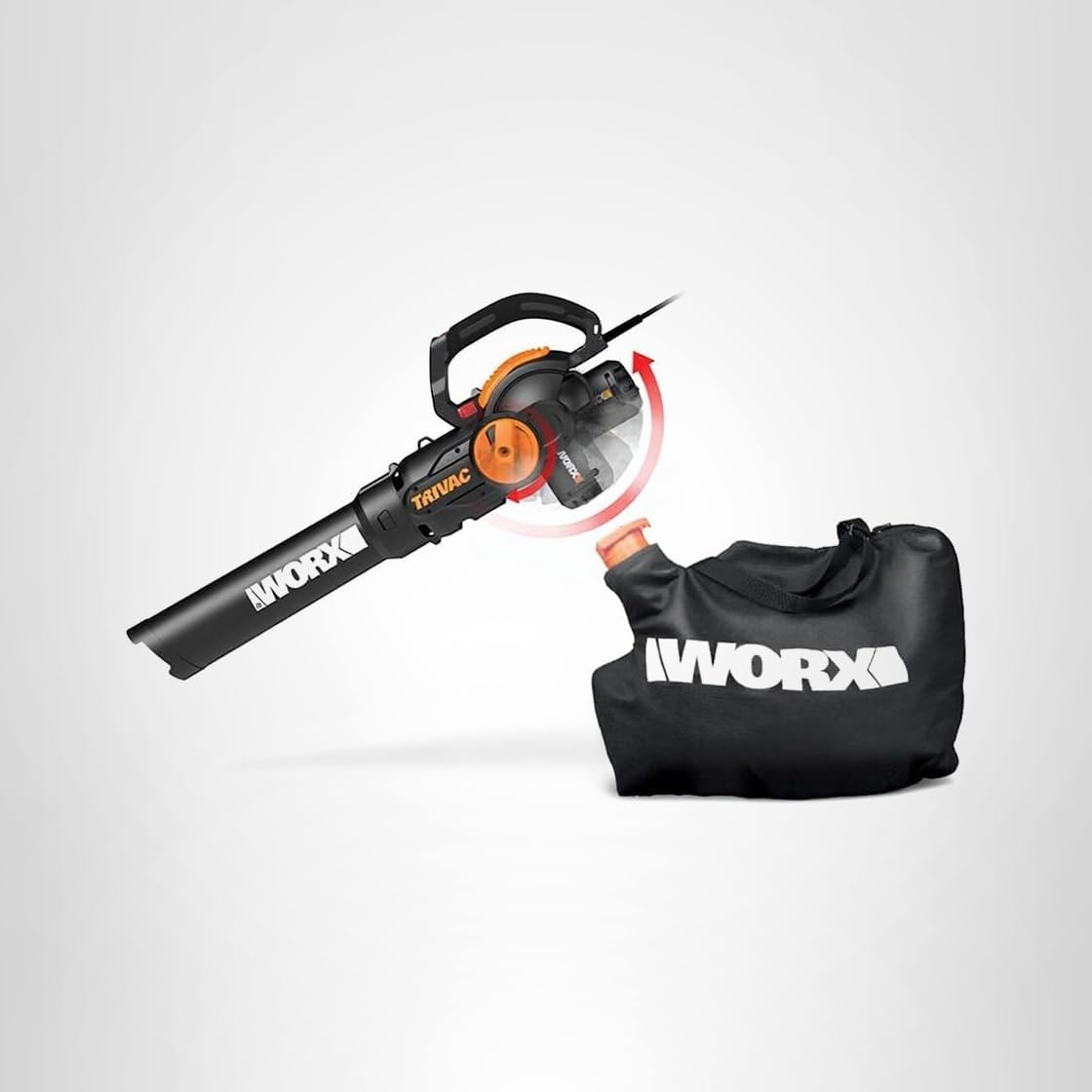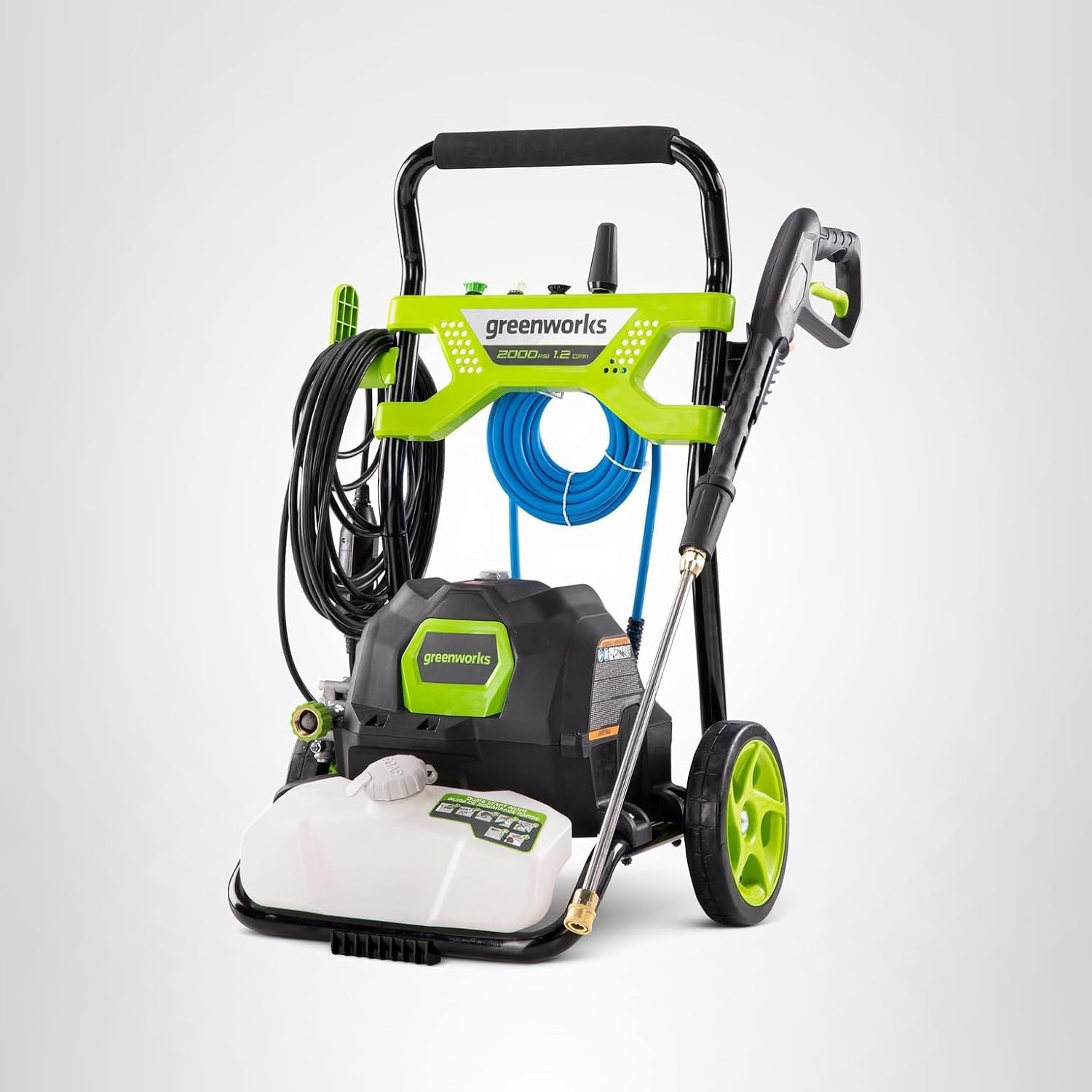The Ultimate Guide to the 7 Best Lawn Fertilizers of 2025

Transform your yard into a lush, green oasis with the right nutrition.
The great American lawn. It’s more than just grass; it’s a symbol of home, a playground for our kids and pets, and the canvas for our summer barbecues. Achieving that deep, lush, barefoot-worthy green carpet is a goal for homeowners across the country, but it doesn’t happen by accident. Just like any living thing, your lawn needs to eat. That’s where fertilizer comes in—it’s the vital nutrition that transforms a patchy, yellowing yard into a neighborhood showpiece.
But walking into the lawn care aisle can be overwhelming. You’re faced with a wall of bags covered in numbers, confusing terms like “slow-release,” “weed and feed,” and N-P-K ratios. It’s easy to feel lost. Are granules better than liquid? Is organic worth it? What do those numbers even mean?
This is your definitive guide. We are going to demystify the world of lawn nutrition. We’ll break down the science in simple terms, review the 7 best lawn fertilizers for every possible need, and give you a step-by-step playbook on how to apply them like a seasoned pro. For a foundational understanding of all the basics, be sure to check out our complete Lawn Care 101 guide. By the end of this article, you’ll have the confidence and knowledge to select and use the perfect fertilizer to build the lawn of your dreams.
The Science of Green: A Fertilizer Crash Course
Before you can choose the right food, you need to understand the menu. Every bag of fertilizer is legally required to display three numbers, known as the N-P-K ratio. This is the key to everything.
Decoding the N-P-K Ratio: The “Big 3” Macronutrients
- N – Nitrogen: This is the superstar of lawn care. Nitrogen’s primary job is to promote vigorous, green, leafy growth. Think of it as the engine of the plant, driving chlorophyll production and giving your lawn its rich color. A higher first number (e.g., 29-0-3) means the formula is focused on greening.
- P – Phosphorus: This nutrient is all about roots and shoots. Phosphorus is crucial for establishing strong, deep root systems and encouraging the growth of new grass blades. This is why “starter” fertilizers for new lawns have a high middle number. Think of it as the foundation of the house.
- K – Potassium (Potash): This is the guardian nutrient. Potassium helps regulate the plant’s internal processes, improves its resilience against drought, disease, and extreme temperatures, and aids in overall cellular function. Think of it as the lawn’s immune system.
Granular vs. Liquid Fertilizers: Which is Right for You?
Fertilizers come in two main forms, each with distinct advantages.
Granular fertilizers are the most common type for homeowners. These are dry pellets you apply with a spreader. Most modern granular products are “slow-release,” meaning the nutrients are coated in a material that breaks down over time, feeding your lawn steadily for 6-8 weeks. This prevents nutrient runoff and reduces the risk of burning your lawn. They are excellent for consistent, long-term health.
Liquid fertilizers are mixed with water and applied with a hose-end sprayer. They provide a rapid dose of nutrients that are absorbed both by the roots and the grass blades (foliar feeding). This makes them fantastic for a quick green-up before a party or for correcting a nutrient deficiency fast. However, they need to be applied more frequently, typically every 2-4 weeks.
The 7 Best Lawn Fertilizers for a Picture-Perfect Yard
We’ve analyzed the market and tested the top contenders to bring you the best fertilizers for every situation your lawn might face.
1. Scotts Turf Builder Lawn Food
Best Overall Performance
Why It Made The List
This is the gold standard for a reason. Scotts Turf Builder is a masterfully balanced, slow-release granular fertilizer that provides a steady, reliable feeding for up to 6 weeks. Its All-in-One Particle technology ensures every single granule contains the full N-P-K ratio, leading to an incredibly even and consistent greening of your lawn. It’s designed to strengthen roots and improve your lawn’s ability to absorb water and nutrients. For the vast majority of established lawns in the U.S., this is the most reliable and effective choice for seasonal feeding.
- N-P-K Ratio: 32-0-4
- Coverage: 5,000 sq. ft. (standard bag)
- Type: Slow-Release Granular
Pros
- Even and consistent greening
- Strengthens root systems effectively
- Slow-release formula prevents lawn burn
- Improves water absorption
Cons
- Does not contain weed or insect control
- Not ideal for brand new lawns
Pro Application Tip
For best results, apply with a broadcast spreader and lightly water it in. Proper watering is key to activation, so consider pairing its application with a run of the best lawn sprinklers for your yard size.
2. Scotts Turf Builder Starter Food for New Grass
New Lawns and Seeding
Why It Made The List
Planting new seed or laying sod is a major investment. This fertilizer is the insurance policy that protects it. Unlike regular fertilizers, this formula is packed with Phosphorus (the ‘P’ in N-P-K), the essential nutrient for rapid root development. It helps new grass seedlings establish faster and grow thicker, leading to a new lawn that fills in more quickly and is more resilient from the start. Using this product can improve seeding results by up to 70% versus an unfed lawn. It’s the critical first meal your new lawn needs to thrive.
- N-P-K Ratio: 24-25-4
- Coverage: 5,000 sq. ft.
- Type: Slow-Release Granular
Pros
- Dramatically improves new grass growth
- High phosphorus content for strong roots
- Can be used with any grass seed type
- Prevents young grass from dying off
Cons
- Not suitable for established lawns
- Phosphorus can be regulated in some states
Pro Application Tip
Apply this fertilizer on the same day you plant your grass seed or lay your sod. It works directly with the new plants to give them the energy they need to establish.
3. Scotts Turf Builder Weed & Feed
Killing Weeds While Greening
Why It Made The List
For homeowners battling dandelions, clover, and other common broadleaf weeds, this 2-in-1 product is a lifesaver. It combines the powerful greening effects of a nitrogen-rich fertilizer with a potent post-emergent herbicide. As it feeds your lawn to help it grow thicker, it simultaneously attacks weeds at the root. A thick, well-fed lawn is naturally better at crowding out weeds, and this product accelerates that process. It’s a highly efficient way to tackle two of the biggest lawn care jobs at once.
- N-P-K Ratio: 28-0-3
- Coverage: 5,000 sq. ft.
- Type: Granular with Herbicide
Pros
- Feeds grass and kills weeds simultaneously
- Effective on over 50 common lawn weeds
- WeedGrip Technology targets weeds you see and those you don’t
- Saves time and effort
Cons
- Must be applied to a wet lawn for herbicide to work
- Not for use on St. Augustinegrass, Floratam, or dichondra lawns
Pro Application Tip
Apply this product in the morning when the grass is damp with dew. The moisture helps the granules stick to the weed leaves for maximum effectiveness. For more persistent weed problems, consider a dedicated liquid lawn weed killer as a follow-up.
4. Milorganite Slow-Release Nitrogen Fertilizer
Best Organic Option
Why It Made The List
Milorganite has a cult following among lawn care enthusiasts, and for good reason. This organic fertilizer is made from heat-dried microbes that have digested wastewater. While that may sound unusual, the result is a nutrient-rich, slow-release fertilizer that is phenomenal for both your grass and your soil. It’s very low in salts, meaning it will never burn your lawn, making it foolproof for beginners. It also contains 2.5% iron, which provides a deep, satisfying green without forcing excessive growth. It feeds the soil, which in turn feeds the grass, leading to superior long-term health.
- N-P-K Ratio: 6-4-0
- Coverage: 2,500 sq. ft.
- Type: Organic Slow-Release Granular
Pros
- Will not burn your lawn—guaranteed
- Improves soil health and structure
- Rich in iron for a deep green color
- Safe for pets and kids immediately after application
Cons
- Has a distinct earthy odor for a day or two
- Lower N-P-K requires more product per application
Pro Application Tip
Because it’s so gentle, Milorganite is great for applying during the summer heat when synthetic fertilizers could stress your lawn. It’s a key component of a comprehensive approach to lawn fertilizing that prioritizes soil health.
5. Simple Lawn Solutions Lawn Food
Best Liquid Fertilizer
Why It Made The List
When you need results fast, liquid is the way to go. This concentrate from Simple Lawn Solutions is a perfectly balanced formula designed for maximum absorption and quick greening. It attaches directly to your hose for an incredibly easy application process. The formula contains a blend of high-quality feed-grade ingredients, including seaweed and fish, that provide nutrients to the soil as well as the grass blades. It’s the perfect tool to have on hand for a quick boost before a holiday weekend or to perk up a lawn that’s looking a bit tired between granular applications.
- N-P-K Ratio: 16-4-8
- Coverage: 3,200 sq. ft.
- Type: Liquid Concentrate
Pros
- Provides rapid greening results
- Easy hose-on application
- Contains both macro and micronutrients
- Feeds both roots and blades (foliar)
Cons
- Needs to be reapplied more frequently
- Can be washed away by heavy rain if not absorbed
Pro Application Tip
Apply liquid fertilizer during the cooler parts of the day, like early morning or evening, to avoid evaporation and allow for maximum absorption through the leaves.
6. Scotts Turf Builder SummerGuard with Insect Control
Summer Stress & Pest Problems
Why It Made The List
Summer is tough on lawns. Heat, drought, and insects can cause serious damage. SummerGuard is a unique multi-tool designed to address all three. It provides a light feeding of slow-release nitrogen that won’t push excessive growth during heat stress. Its main feature is the built-in insecticide that kills and prevents common lawn-damaging pests like ants, ticks, and chinch bugs. It also helps the lawn make the most of the water it gets. It’s the perfect mid-summer application to keep your lawn healthy and protected when it’s most vulnerable.
- N-P-K Ratio: 20-0-8
- Coverage: 5,000 sq. ft.
- Type: Granular with Insecticide
Pros
- Feeds, strengthens, and kills bugs
- Protects against heat and drought stress
- Kills dozens of listed surface and subsurface insects
- Water-smart formula improves water retention
Cons
- Not a primary deep-feeding fertilizer
- Insecticide is a chemical control method
Pro Application Tip
This product is a great part of an integrated pest management strategy. For more comprehensive information on dealing with lawn invaders, check out our guide to lawn pest control.
7. Ironite Mineral Supplement
Deep, Dark Green Color
Why It Made The List
Sometimes your lawn is healthy but just lacks that deep, emerald, golf-course green. The secret ingredient is often iron. Ironite is not a primary fertilizer but a mineral supplement designed to correct iron deficiency (chlorosis), which often appears as yellowing grass. It provides a massive dose of soluble iron that gives your lawn a rapid, dramatic greening effect without forcing the fast growth that comes from high-nitrogen formulas. Using Ironite a couple of times a year in addition to your regular fertilizing program can take your lawn’s color to the next level.
- N-P-K Ratio: 1-0-1 (plus 20% Iron)
- Coverage: 5,000 sq. ft.
- Type: Granular Mineral Supplement
Pros
- Provides a very deep, dark green color
- Works quickly to correct yellowing lawns
- Doesn’t stain concrete when used as directed
- Low nitrogen won’t cause surge growth
Cons
- Not a complete fertilizer; must be used with one
- Can stain pavement if not swept up before watering
Pro Application Tip
After applying Ironite or any granular product, use one of the best lawn blowers to quickly and easily clear any stray pellets from your driveway and sidewalks before you water them in. This prevents staining.
How to Fertilize Your Lawn Like a Pro: A Step-by-Step Guide
Having the best fertilizer means nothing if you don’t apply it correctly. Follow these steps for a flawless, even application.
Step 1: Timing is Everything
Fertilize when the grass is actively growing. For cool-season grasses (Fescue, Bluegrass), this is primarily in the spring and fall. For warm-season grasses (Bermuda, Zoysia), this is from late spring through summer. Avoid fertilizing dormant lawns.
Step 2: Prepare the Lawn
Mow your lawn one or two days before you plan to fertilize. This allows the grass blades to heal and be ready to accept nutrients. It also makes it easier to walk and push the spreader.
Step 3: Calibrate Your Spreader
This is the most important and most-skipped step. Read the back of the fertilizer bag to find the correct setting for your specific spreader model (e.g., Scotts Broadcast Spreader, setting 5 ¾). This ensures you’re applying the exact right amount of product.
Step 4: The Application
First, apply a “header strip” or “trim pass” by going around the entire perimeter of your lawn. This gives you a buffer zone to turn around in. Then, fill in the middle by walking back and forth in straight, slightly overlapping lines, like you’re mowing. Walk at a steady, consistent pace. Shut the spreader off whenever you stop walking to prevent piles of fertilizer that can burn the lawn.
Step 5: Water it In
Unless you’re using a weed-and-feed product that needs to stick to leaves, you should water your lawn lightly after application. This helps wash the fertilizer off the grass blades and down to the soil where the roots can access it. It also activates the slow-release mechanism in the granules.
The Integrated Lawn Care Strategy
Fertilizer is a cornerstone, but it works best as part of a complete lawn care system. A truly great lawn requires a holistic approach.
- Mowing: The foundation of good lawn care. Mowing high encourages deep roots. For a pristine look, nothing beats a clean line along the driveway, which you can achieve with one of the best lawn edgers. And for keeping the edges neat, you’ll need one of the best lawn trimmers of 2025. For those who want to automate this task, the future is now with the best robotic lawn mowers.
- Weed and Pest Control: A well-fed lawn will choke out many weeds, but some will always break through. An integrated strategy using both pre- and post-emergent controls is key.
- Tool Upkeep: A healthy lawn is easier to maintain when you have the right equipment. Make sure you’re outfitted with the best lawn tools of 2025 to make the job easier and more effective.
Frequently Asked Questions (FAQ)
What do the numbers on the fertilizer bag mean?
The three numbers represent the percentage by weight of Nitrogen (N), Phosphorus (P), and Potassium (K). A 50-pound bag of 20-5-10 fertilizer contains 10 pounds of Nitrogen (20% of 50), 2.5 pounds of Phosphorus (5% of 50), and 5 pounds of Potassium (10% of 50).
Can I fertilize a wet lawn?
For most fertilizers, yes. Applying to a damp lawn is fine. The major exception is “Weed & Feed” products, which specifically require a wet lawn so the herbicide granules can stick to the leaves of the weeds.
Is lawn fertilizer safe for my pets and kids?
Once the product has been watered in and the lawn has had time to dry completely, it is generally considered safe for pets and kids to return to the area. Organic fertilizers like Milorganite are safe immediately. However, always read and follow the specific safety instructions on the product label.
Conclusion: Feed Your Way to a Flawless Lawn
Fertilizer is the key that unlocks your lawn’s potential. By understanding the nutritional needs of your grass and choosing a product tailored to its specific situation—whether it’s a new seeding, a weed invasion, or a need for a deeper green—you are taking control of your lawn’s health and beauty. The perfect lawn isn’t a mystery; it’s the result of a thoughtful plan and the right nutrition. Now, you have the knowledge to create that plan and build the lush, stunning lawn you’ve always wanted.






















